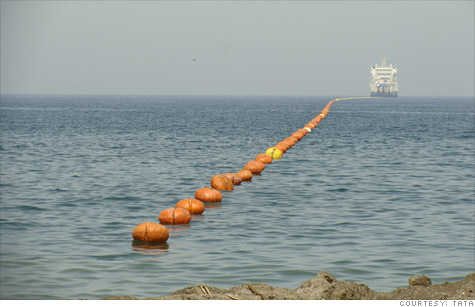Location:Home > News >
A giant undersea cable makes Internet a split-second faster
A giant undersea cable makes the Internet a split-second faster——ChangGuang Focus

A ship leaving the United Arab Emirates uses weights attached to buoys to help sink an underwater Internet cable.
NEW YORK (CNNMoney) -- Did you ever wonder how people in Japan connect to websites hosted in San Francisco? Or how a New Yorker can Skype with a friend in Sydney?
It sounds crazy, but Earth's continents are physically linked to one another through a vast network of subsea, fiber-optic cables that circumnavigate the globe. Cords no thicker than your home's broadband connection stretch along the bottom of the Pacific, Atlantic, and Indian Oceans; through the Suez canal; across the Mediterranean Sea and around the coasts of Africa and South America.
Indian telecom giant Tata, one of the world's largest subsea cable providers, manages 130,500 miles of fiber sitting at the bottom of the ocean floor. That's enough to circle the planet five times. It takes a ship six weeks just to load the cable for a cross-ocean voyage.
Why is all that underwater cable necessary? It's a matter of speed, and laying in enough safeguards to ensure that the Internet won't suddenly go down.
Subsea fiber-optic cables can tie two giant centers of commerce together, reducing data traffic delays. Three companies are in the process of building cable networks that link London directly to Tokyo -- through the polar ice cap -- with cables capable of 10 gigabit-per-second speeds. (That's 2,000 times faster than your home Internet connection).
Those cables could reduce the Internet's latency by about 60 milliseconds between those two points.
That's an imperceptible lag for the average Internet user, but it's an eternity for high-speed stock traders. They can make or lose millions of dollars in that span of time.
It's not just financial institutions, which make up a very small portion of total Internet usage, that are interested in faster speeds. Internet service providers like Comcast (CMCSA, Fortune 500) and Time Warner Cable (TWC, Fortune 500) like to go zoom as well, because it gives them capacity to meet the growing demands on their networks.
Subsea cables have the added benefit of being shielded from wind, trees, storms and other destructive forces. They don't require massive towers to carry them, like over-the-land cables do.
They're literally just laid on the bottom of the sea, and once placed there, they can more or less be left untouched for a quarter century.
But sometimes cables get cut, particularly in shallow water. They get accidentally clipped by ship anchors about twice a year.
It happened most recently a month ago, when a ship dropped anchor off the coast of Kenya and cut Internet service for much of the country. Google noticed a steep drop in availability of its services in Kenya on Feb. 25.
That's why cables are outfitted with GPS, so ships can find and patch them when they break. There are outsourced companies on the clock 24/7 to do repairs at a moment's notice.
Having multiple cables connecting continents from many different locations means the Internet is less likely to be massively disrupted when a cable is snapped.
That's why Tata says it was critical to build the final leg in the world's first round-the-planet network, which it completed last week. The final cable connects Mumbai to Marseille, France. Tata's other links tie the United Kingdom to New Jersey, Spain to Africa and Japan to Australia.
Together, those pipes handle 25% of the world's Internet traffic. Tata wouldn't put a price tag on the project, but an under-construction arctic cable linking Asia, North America and Europe has an estimated cost of $1.5 billion.
The upshot of all that investment is that if one cable snaps, you'll still be able to play "Words with Friends" with a partner 10,000 miles away.
Get in Touch
+86-21-3996-3837
alex@changguangchina.com
+86-15216725374


